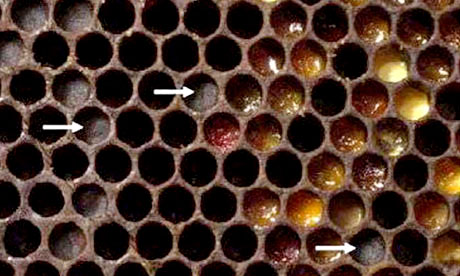|
by Fiona Harvey from Guardian Website
Photograph: Journal
of Invertebrate Pathology
Honeybees are taking emergency measures
to protect their hives from
pesticides, in an extraordinary example
of the natural world adapting swiftly to our depredations, according
to a prominent bee expert.
The pollen stored in the sealed-up cells has been found to contain dramatically higher levels of pesticides and other potentially harmful chemicals than the pollen stored in neighboring cells, which is used to feed growing young bees.
But the bees' last-ditch efforts to save themselves appear to be unsuccessful - the entombing behavior is found in many hives that subsequently die off, according to Pettis.
These colonies were likely to already be
in trouble, and their death could be attributed to a mix of factors
in addition to pesticides, he added.
These substances may also be harmful to bees, Pettis said.
The decline of bee populations has become an increasing concern in recent years.
"Colony collapse disorder", the name given to the unexplained death of bee colonies, is affecting hives around the world. Scientists say there are likely to be numerous reasons for the die-off, ranging from agricultural pesticides to bee pests and diseases, pollution, and intensive farming, which reduces bee habitat and replaces multiple food sources with single, less nutritious, sources.
Globalization may also be a factor, as
it spreads bee diseases around the world, and some measures taken to
halt the deaths - such as massing bees in huge super-hives - can
actually contribute to the problem, according to a
recent study by the United Nations.
Some pesticides could be improving life for bees, he noted:
Studies he conducted found that bees in areas of intensive agriculture were suffering from poor nutrition compared with bees with a diverse diet, and this then compounded other problems, such as infection with the gut parasite nosema.
The entombing phenomenon was first noted
in an obscure scientific paper from 2009 (Inefficient
Task Partitioning Among Nonhygienic Honeybees, Apis Mellifera L. -
Implications for Disease Transmission), but since then
scientists have been finding the behavior more frequently, with the
same results.
It is used by bees to line the walls of
their hives, and to seal off unwanted or dangerous substances - for
instance, mice that find their way into hives and die are often
found covered in propolis. This is the substance bees are using to
entomb the cells.
Pettis said that it seemed pollen-collecting bees could not detect
high levels of pesticides, but that the pollen underwent subtle
changes when stored. These changes - a lack of microbial activity
compared with pollen that has fewer pesticide residues - seemed to
be involved in triggering the entombing effect, he explained.
|

